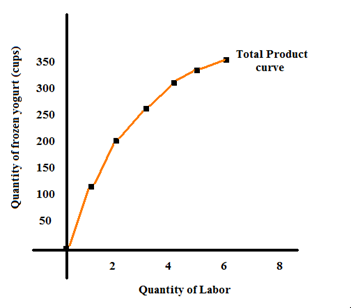
Concept Introduction:
Fixed input: It is an input, which is constant in the short run, it is not related to any change in the production of goods or service, it will be fixed disregarding of an increase or decrease in output.
Variable input: This input is directly proportional to the level of output produced, it increases with an increase in output and vice versa.
Marginal Product of Labor (MPL): It refers to the additional units of output, which is produced by employing an additional unit of labor in the current labor force.

Here,
 is the change in quantity.
is the change in quantity.  is the change in labor.
is the change in labor.
Explanation of Solution
a. Fixed input and variable input.
- In this case, the fixed input are machines, refrigerator and yogurt.
- Variable inputs are workers, toppings for sprinkling, cups, yogurt mix.
Conclusion:
There are three fixed inputs and the others are variable inputs.
b. Total Product curve:

Fig 1
- More quantity of frozen yogurt will be produced as more workers are employed so the total product curve will slope upwards.
- Total product curve will start from the origin, on the y-axis quantity of frozen yogurt is measured and on the x-axis quantity of labor is measured.
Conclusion:
The total product curve will slope upwards.
c. Marginal product will decline with an increase in the number of workers:
The marginal product of the first labor is:

The marginal product of the second labor is:

The marginal product of the third labor is:

- With an increase in the labor, marginal productivity will decline, so it can be said that with the working of each additional labor, it will be working with the smaller share of the fixed inputs.
- Production of an additional labor will be less than the previous labor.
Conclusion:
Therefore, the marginal product of an additional labor will fall.
Want to see more full solutions like this?
Chapter 6 Solutions
EBK ESSENTIALS OF ECONOMICS
- Answerarrow_forwardM” method Given the following model, solve by the method of “M”. (see image)arrow_forwardAs indicated in the attached image, U.S. earnings for high- and low-skill workers as measured by educational attainment began diverging in the 1980s. The remaining questions in this problem set use the model for the labor market developed in class to walk through potential explanations for this trend. 1. Assume that there are just two types of workers, low- and high-skill. As a result, there are two labor markets: supply and demand for low-skill workers and supply and demand for high-skill workers. Using two carefully drawn labor-market figures, show that an increase in the demand for high skill workers can explain an increase in the relative wage of high-skill workers. 2. Using the same assumptions as in the previous question, use two carefully drawn labor-market figures to show that an increase in the supply of low-skill workers can explain an increase in the relative wage of high-skill workers.arrow_forward
- Published in 1980, the book Free to Choose discusses how economists Milton Friedman and Rose Friedman proposed a one-sided view of the benefits of a voucher system. However, there are other economists who disagree about the potential effects of a voucher system.arrow_forwardThe following diagram illustrates the demand and marginal revenue curves facing a monopoly in an industry with no economies or diseconomies of scale. In the short and long run, MC = ATC. a. Calculate the values of profit, consumer surplus, and deadweight loss, and illustrate these on the graph. b. Repeat the calculations in part a, but now assume the monopoly is able to practice perfect price discrimination.arrow_forwardThe projects under the 'Build, Build, Build' program: how these projects improve connectivity and ease of doing business in the Philippines?arrow_forward

 Principles of Economics (12th Edition)EconomicsISBN:9780134078779Author:Karl E. Case, Ray C. Fair, Sharon E. OsterPublisher:PEARSON
Principles of Economics (12th Edition)EconomicsISBN:9780134078779Author:Karl E. Case, Ray C. Fair, Sharon E. OsterPublisher:PEARSON Engineering Economy (17th Edition)EconomicsISBN:9780134870069Author:William G. Sullivan, Elin M. Wicks, C. Patrick KoellingPublisher:PEARSON
Engineering Economy (17th Edition)EconomicsISBN:9780134870069Author:William G. Sullivan, Elin M. Wicks, C. Patrick KoellingPublisher:PEARSON Principles of Economics (MindTap Course List)EconomicsISBN:9781305585126Author:N. Gregory MankiwPublisher:Cengage Learning
Principles of Economics (MindTap Course List)EconomicsISBN:9781305585126Author:N. Gregory MankiwPublisher:Cengage Learning Managerial Economics: A Problem Solving ApproachEconomicsISBN:9781337106665Author:Luke M. Froeb, Brian T. McCann, Michael R. Ward, Mike ShorPublisher:Cengage Learning
Managerial Economics: A Problem Solving ApproachEconomicsISBN:9781337106665Author:Luke M. Froeb, Brian T. McCann, Michael R. Ward, Mike ShorPublisher:Cengage Learning Managerial Economics & Business Strategy (Mcgraw-...EconomicsISBN:9781259290619Author:Michael Baye, Jeff PrincePublisher:McGraw-Hill Education
Managerial Economics & Business Strategy (Mcgraw-...EconomicsISBN:9781259290619Author:Michael Baye, Jeff PrincePublisher:McGraw-Hill Education





